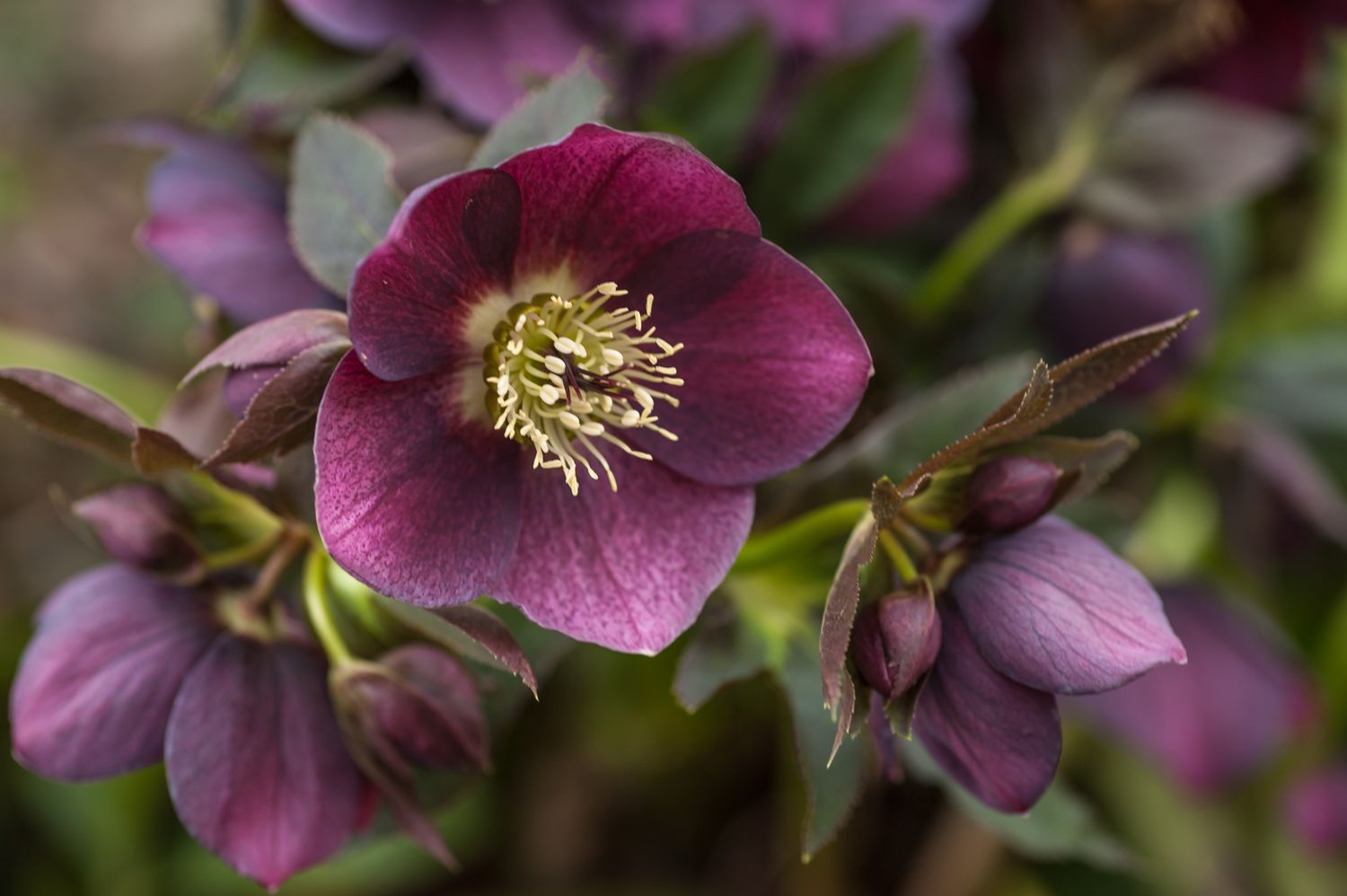
Hellebore, also known as the Christmas Rose or Lenten Rose, is a captivating and enchanting flower that holds a unique place in the plant kingdom. With its delicate blooms and evergreen foliage, hellebore has been cherished for centuries for its beauty and intriguing characteristics.
In this article, we will delve into 18 fascinating facts about hellebore, uncovering the secrets and wonders of this extraordinary plant. From its interesting history to its incredible resilience, hellebore never fails to amaze and captivate garden enthusiasts and botany lovers alike.
So, whether you are a seasoned gardener or simply someone who appreciates the beauty of flowers, join us on this journey as we explore the fascinating world of hellebore and discover the many reasons why it has become a beloved plant among horticulturists and nature enthusiasts.
Key Takeaways:
- Hellebore, also known as the Christmas Rose, is a fascinating plant with a rich history of medicinal use, diverse flower colors, and a unique ability to bloom in winter, making it a captivating addition to any garden.
- With its nodding flowers, deer-resistant nature, and long-lasting blooms, hellebore is not only a beautiful and resilient plant but also a valuable addition to pollinator-friendly gardens.
Hellebore is a member of the buttercup family.
Belonging to the Ranunculaceae family, hellebore shares its botanical lineage with beautiful flowers like anemones, peonies, and buttercups.
It is native to Europe and Western Asia.
Hellebore is found naturally in various regions of Europe, including the Mediterranean and the Balkan Peninsula. It also grows in parts of Western Asia, particularly in Turkey and the Caucasus.
The name “Hellebore” has Greek origins.
The name hellebore is derived from the Greek word “elein” which means “to injure” or “to harm.” This name reflects the plant’s historical use as a powerful medicinal herb.
Hellebore has a long history of medicinal use.
For centuries, hellebore has been used in traditional medicine to treat various ailments, including digestive issues, nervous disorders, and even as an antidote for poisoning.
Hellebore flowers are typically nodding.
The unique structure of hellebore flowers causes them to face downward, creating an enchanting display when they bloom in late winter or early spring.
There are over 20 recognized species of hellebore.
While the most commonly cultivated species is Helleborus orientalis, there are numerous other species and hybrid varieties that showcase a wide range of colors and forms.
Hellebore belongs to the perennial plant group.
Perennial plants are those that live for more than two years, and hellebore fits perfectly into this category. With proper care, hellebores can thrive for many years, providing beauty to your garden season after season.
Hellebore flowers come in various colors.
From shades of white, pink, purple, and green to even dark maroon and black, hellebore flowers offer a diverse range of colors, adding vibrancy to any garden.
Hellebore is a winter-blooming plant.
Unlike most plants that remain dormant during the winter months, hellebore defies the cold with its early blooming habit. It often flowers in late winter or early spring, bringing much-needed color and cheer to the garden.
It prefers shade or partial shade.
Hellebore thrives in shady or partially shady areas, making it an excellent choice for woodland gardens, shady borders, or under trees where other plants struggle to grow.
Hellebore has unique foliage.
The leaves of hellebore are deeply lobed, giving them an ornamental appeal even when the plant is not in bloom. The glossy, dark green foliage adds texture and interest to the garden.
Hellebore can be toxic if ingested.
While hellebore has many positive attributes, it is important to note that all parts of the plant are toxic if eaten. Keep it out of reach from curious pets and children.
The flowers of hellebore are long-lasting.
Hellebore flowers have a remarkable longevity, often staying in bloom for several weeks or even months. This resilience adds to their desirability as a garden plant.
Hellebore is a popular choice for winter weddings.
Thanks to its early blooming nature and delicate beauty, hellebore is highly sought after for bridal bouquets, centerpieces, and other winter wedding floral arrangements.
Hellebore seeds have a low germination rate.
Germinating hellebore seeds can be a patience-testing task, as they have naturally low germination rates and can take several months or even years to sprout.
Hellebore is a magnet for pollinators.
The nodding flowers of hellebore attract various pollinators such as bees and butterflies, making it a valuable addition to any pollinator-friendly garden.
Hellebore is deer-resistant.
Deer tend to avoid hellebore due to its poisonous nature, making it an excellent choice for gardens frequented by these browsing animals.
Hellebore has inspired many varieties and hybrids.
Over the years, hellebore enthusiasts and breeders have introduced a wide array of hybrid varieties that showcase unique characteristics such as double flowers, speckled petals, and ruffled edges.
In conclusion, the 18 fascinating facts about hellebore demonstrate the plant’s rich history, diverse beauty, and unique qualities. Whether you’re captivated by its medicinal properties or captivated by its enchanting flowers, hellebore is a plant that continues to pique curiosity and inspire admiration.
Conclusion
In conclusion, Hellebore is a truly fascinating plant with a rich history and unique characteristics. From its early use as a medicinal herb to its beautiful and diverse blooms, Hellebore continues to captivate plant enthusiasts and gardeners alike. Whether you’re drawn to its winter flowering period, its ability to thrive in shade, or its wide range of colors and forms, Hellebore is sure to add beauty and charm to any garden or landscape. So why not consider adding this enchanting perennial to your plant collection? You’ll be rewarded with its resilience, elegance, and the joy it brings year after year.
FAQs
Q: Are Hellebores toxic?
A: Yes, Hellebores can be toxic if ingested, so it’s important to keep them out of reach of children and pets.
Q: Do Hellebores require a lot of sunlight?
A: Hellebores are known for their ability to thrive in shade and are often grown in woodland gardens or under trees. While they can tolerate some sunlight, they generally prefer partial shade to full shade conditions.
Q: How do I care for Hellebores in the winter?
A: Hellebores are extremely hardy plants and can withstand cold temperatures. However, in regions with severe winters, it’s a good idea to provide some protection by covering the plants with a layer of mulch or dry leaves to insulate the roots.
Q: Can I grow Hellebores in containers?
A: Yes, Hellebores can be grown in containers, making them a great choice for gardens with limited space or for those who enjoy container gardening. Just make sure the container has good drainage and use a well-draining potting mix.
Q: How do I propagate Hellebores?
A: Hellebores can be propagated through division or by growing them from seeds. Division is typically done in early spring when the plants are still dormant, while growing from seeds requires patience as it can take several years for the plants to reach maturity.
Hellebore's alluring qualities have likely piqued your curiosity. Delving deeper into this captivating plant's world reveals even more intriguing facts waiting to be explored. From its ancient medicinal uses to the stunning varieties that grace gardens today, hellebore continues to fascinate plant enthusiasts and nature lovers alike. So, if you find yourself yearning to learn more about this enchanting flower, why not embark on a journey to uncover the additional secrets it holds?
Was this page helpful?
Our commitment to delivering trustworthy and engaging content is at the heart of what we do. Each fact on our site is contributed by real users like you, bringing a wealth of diverse insights and information. To ensure the highest standards of accuracy and reliability, our dedicated editors meticulously review each submission. This process guarantees that the facts we share are not only fascinating but also credible. Trust in our commitment to quality and authenticity as you explore and learn with us.


